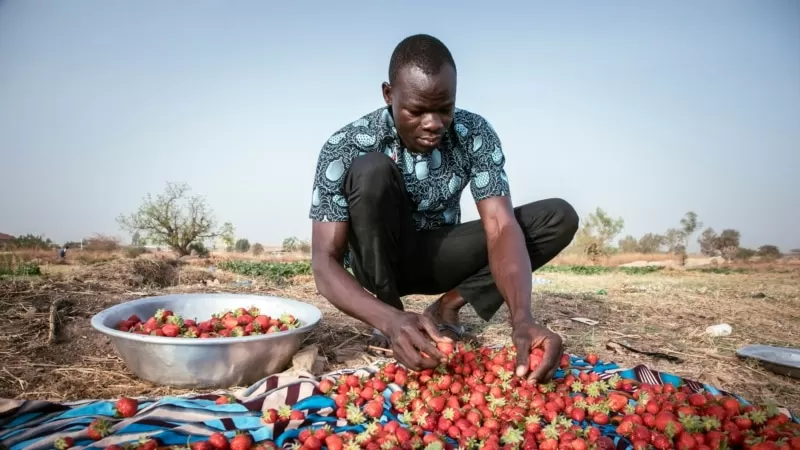Ouagadougou, Burkina Faso – In the suburbs of Burkina Faso’s capital city, Ouagadougou, a new trend is emerging in the agricultural sector. Strawberry farming, once seen as an unlikely practice in this semi-arid West African country, has now become a top export to neighboring countries, earning it the nickname “red gold” in the Sahel region.
According to the agricultural support program PAPEA, strawberry crops brought in an impressive $3.3 million from 2019 to 2020. This has sparked a shift in the farming landscape, with traditional crops like cabbage and lettuce being replaced by the more lucrative strawberry farming.
In the working-class Boulmiougou district on the outskirts of Ouagadougou, farmer Yiwendenda Tiemtore has been busy harvesting the red fruit since dawn, before temperatures rise to a scorching 40 degrees Celsius. Tiemtore, like many other farmers in the area, has switched to cultivating strawberries during their January to April season, as they bring in higher profits compared to other crops.
Despite the surprise of strawberries thriving in a semi-arid country, Burkina Faso leads the region in strawberry production, growing about 2,000 tons a year. This is due to the ample sunlight and water that the crop requires, making it a perfect fit for the country’s climate.
While strawberries are highly prized by local customers, more than half of the production is exported to neighboring countries. “We receive orders from abroad, particularly from Ivory Coast, Niger, and Ghana,” says market gardener Madi Compaore, who specializes in strawberries and trains local growers. The demand for Burkina’s popular strawberry varieties, “selva” and “camarosa,” is constantly rising, and the prices are good, making it a profitable business for both growers and sellers.
In season, strawberries are sold at a higher price compared to other fruits and vegetables, fetching $5 per kilogram. This has been a boon for the country’s economy, especially in the face of insecurity caused by jihadi violence and the repercussions of two coups in 2022.
Apart from Ouagadougou, strawberry production is also prominent in Bobo-Dioulasso, Burkina’s second city. However, Compaore notes that “the sector’s not very well organized” there. But this has not stopped the practice from becoming a fixture in the country since the 1970s.
The origins of strawberry farming in Burkina Faso can be traced back to a French expatriate who introduced a few plants to his garden in the country. Since then, more and more people have taken up the practice, recognizing it as a profitable business opportunity. “It’s our red gold. It’s one of the most profitable crops for both growers and sellers,” explains Compaore.
Seller Jacqueline Taonsa has also recognized the potential of strawberry farming and has no hesitation in swapping from selling apples and bananas to strawberries in season. “With the heat, it’s hard to keep strawberries fresh for long,” says Taonsa, who cycles around Ouagadougou neighborhoods balancing a salad bowl on her head. “So, we take quantities that can be sold quickly during the day,” she explains. On average, she sells about 5 to 6 kilograms of strawberries per day.
Adissa Tiemtore, who used to be a full-time fruit and vegetable seller, has also switched to selling woven loincloths. However, she takes up her strawberry business again during the three-month fruit-producing season due to its lucrative margins, which can reach up to “200-300%.” “I start strawberry selling again when they’re in season to make a bit of money and satisfy my former customers, who continue to ask for them,” she says.
Tiemtore and other sellers go around to different growers, depending on the day they are harvesting, to ensure a steady supply of strawberries to sell throughout the season. However, the end of April marks the end of the strawberry bonanza, and they go back to their other activities, eagerly awaiting the next season.
In conclusion, strawberry farming has become a booming industry in Burkina Faso, bringing in significant profits for both growers and sellers. Despite its surprising success in a semi-arid country, it has become a fixture in the country’s agriculture sector since the


